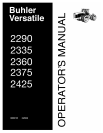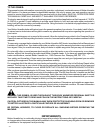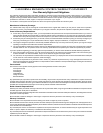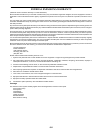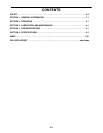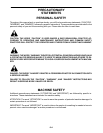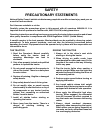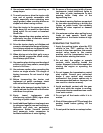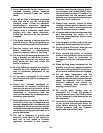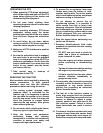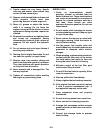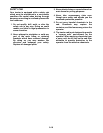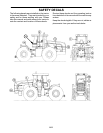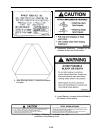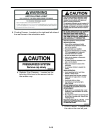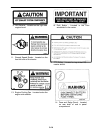
0-7
8. Do not operate the tractor engine in an
enclosed building without adequate
ventilation. Exhaust fumes can cause
death.
9. The cab air filter is designed to remove
dust from the air but will not exclude
chemical vapor. Follow the chemical
manufacturer’s directions regarding
protection from dangerous chemicals.
10. Always wear a protective mask when
working with toxic spray chemicals.
Follow the directions on the chemical
container.
11. If the power steering or engine ceases to
operate, stop the tractor immediately as
the tractor will be more difficult to control.
12. Stop the engine and relieve pressure
before connecting or disconnecting
hydraulic, steering, water, or fuel lines.
13. Pull only from the swinging drawbar. Use
only a drawbar pin that locks in place.
Pulling from the tractor rear axle or any
point above the axle may cause the
tractor to overturn.
14. Be sure hydraulic couplers are properly
mounted and will disconnect safely in
case of accidental detachment of the
implement.
15. Do not leave equipment in the raised
position when the vehicle is stopped or
unattended.
16. Ensure any attached equipment or
accessories are correctly installed, are
approved for use with the tractor, do not
overload the tractor and are operated and
maintained in accordance with the
instructions issued by the equipment or
accessory manufacturer.
17. Remember that your tractor, if abused or
incorrectly used, can be dangerous and
become a hazard both to the operator and
to bystanders. Do not overload or operate
with attached equipment which is unsafe,
not designed for the particular task, or is
poorly maintained.
18. The cab is designed to provide the
minimum noise level at the operator’s
ears and, in fact, m eets or exceeds
applicable standards in this respect.
However, noise (sound pressure level) in
the workplace can exceed 86dB(A) when
the cab windows are open. Therefore, it is
recommended that the operators wear
suitable ear protectors when operating in
high noise level conditions.
19. Always keep sleeves, jackets or other
clothing relatively tight and belted. Loose
clothing may catch in moving parts and
result in personal injury or death.
20. Use steps and handholds when mounting
and dismounting the tractor or for
servicing components too high to reach
from the ground.
21. Lock the seat in position and buckle your
safety belt before operating the tractor.
22. Do not operate the tractor when you are
tired, sick, or impaired in any way.
23. Never operate the tractor in confined
areas, or when visibility next to the tractor
is reduced. Injury to bystanders or
damage to the tractor or equipment may
result.
24. When hitching drawn equipment to the
drawbar, only allow an assistant between
the tractor and implement if the tractor is
off, in neutral and thebrakes are engaged.
25. Do not leave implements with the
hydraulic cylinders fully extended or
retracted where the heat from the sun can
cause the hydraulic fluid to expand.
Hydraulic pressure can rupture the
hoses, releasing high pressure oil
causing personal injury.
26. Be careful when turning with an
implement. Lift it from the ground if
possible during turns. Side thrust caused
by the implement could damage the tire
and implement.
27. Use transport locks, lower the implement
to the ground and securely block the
frame before servicing the implement.
Relieve pressure from the hydraulic
system and shut off the tractor.



